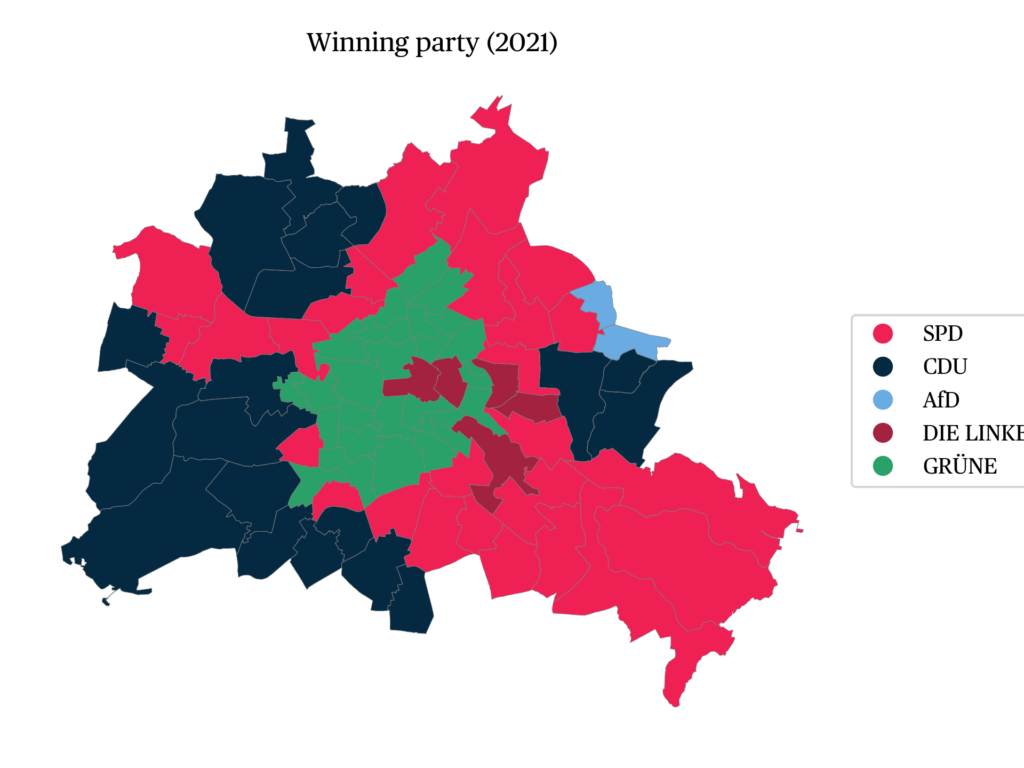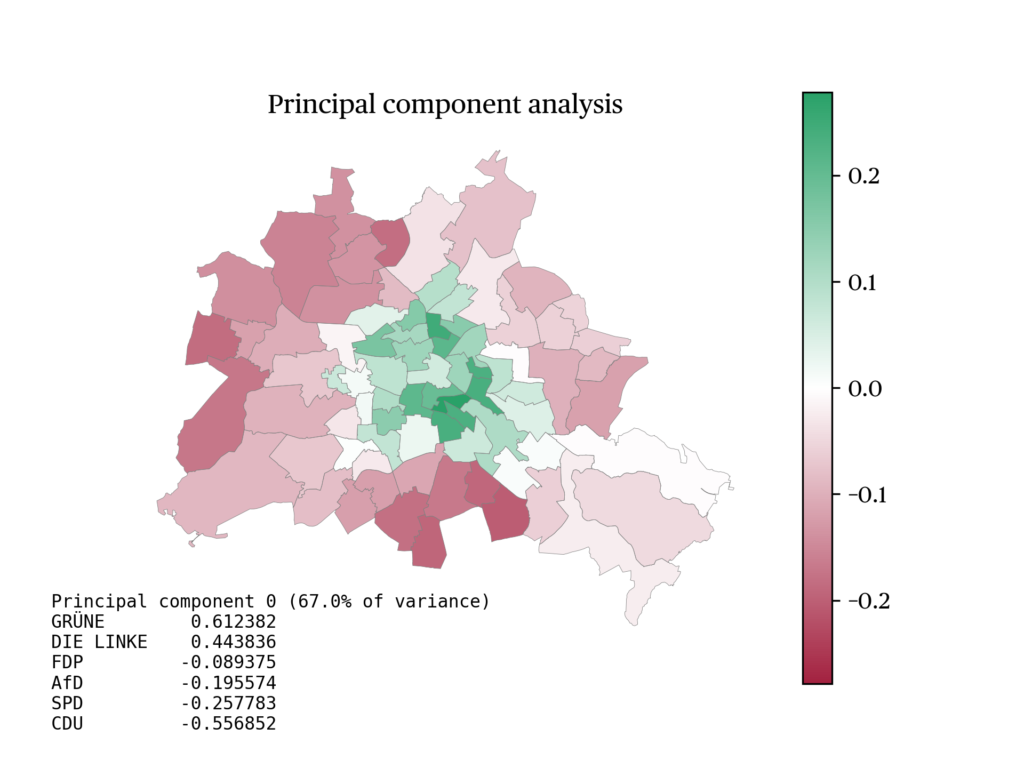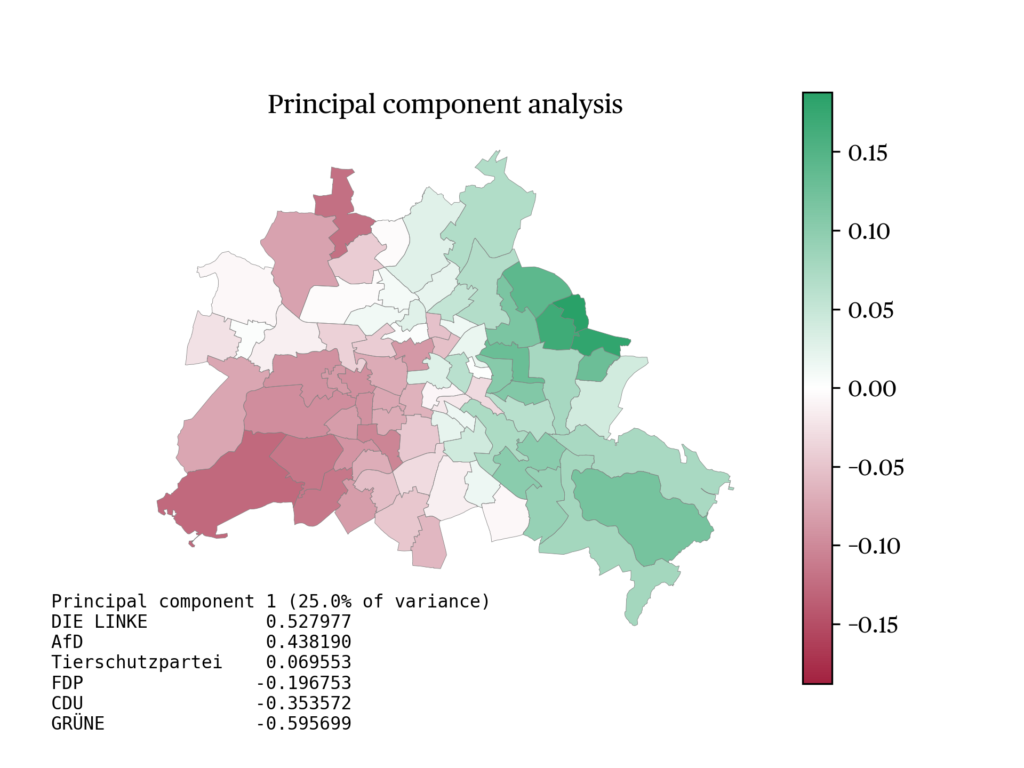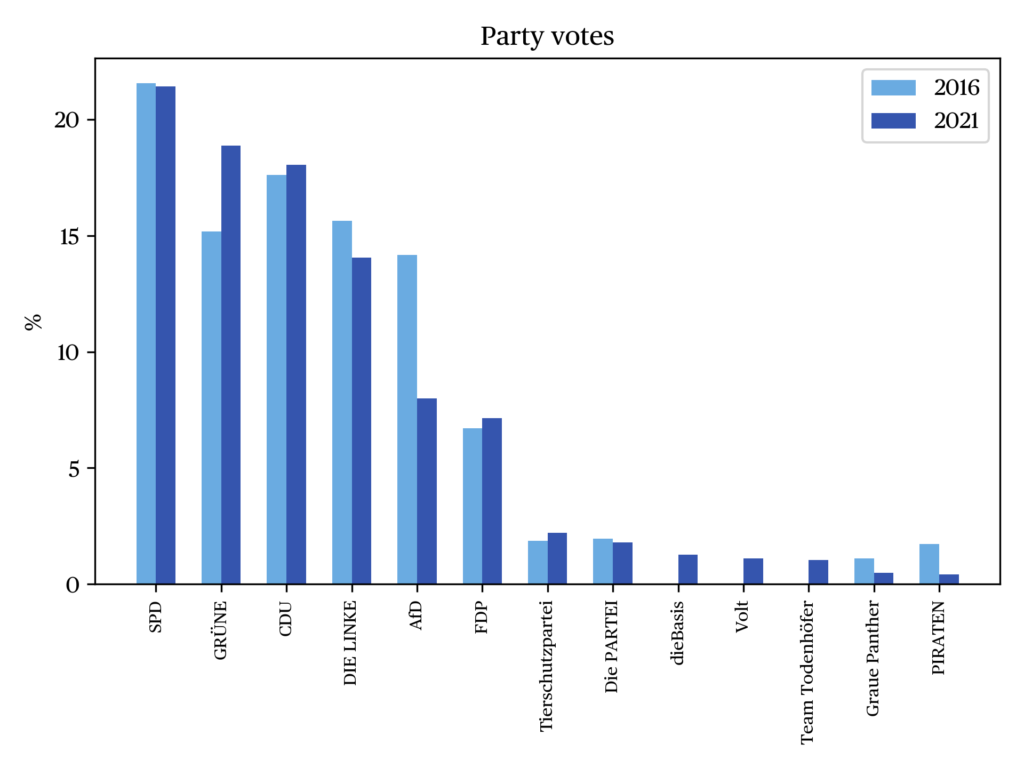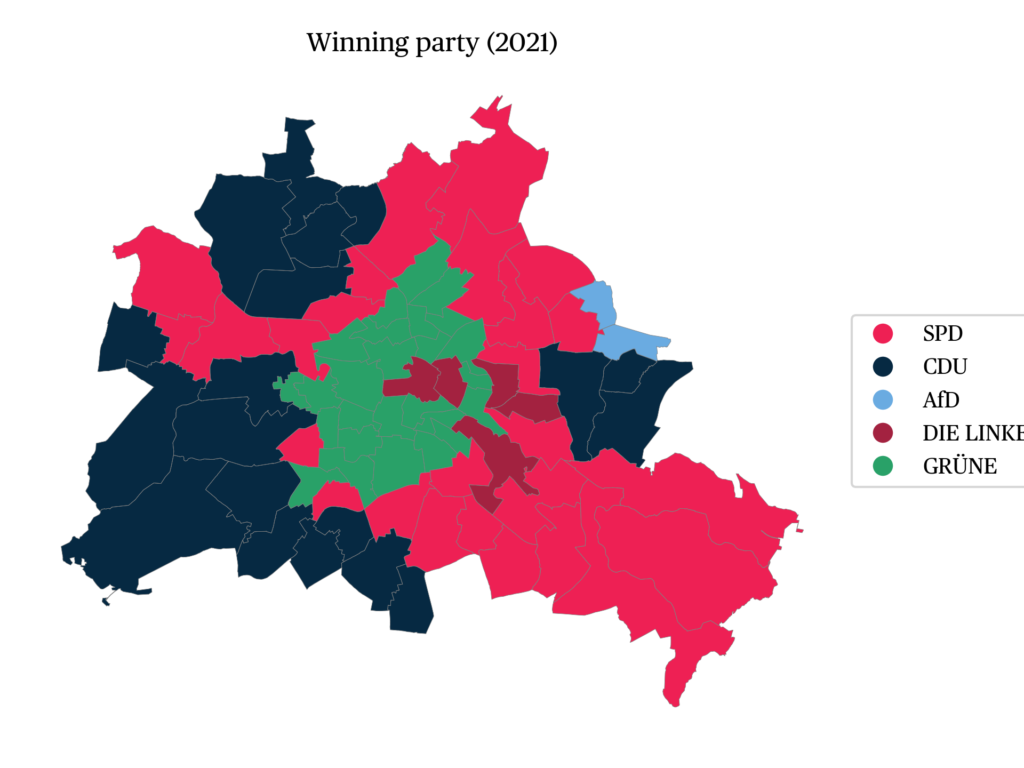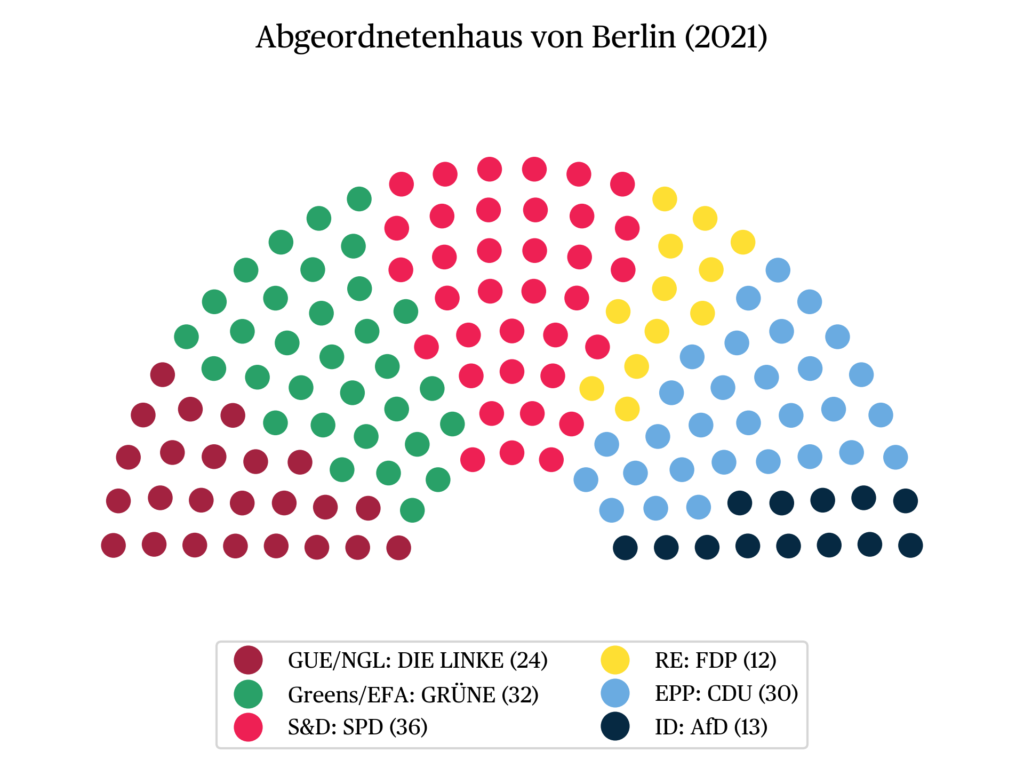Regional election in Berlin, 26 September 2021

François Hublet
Editor-in-chief, BLUEIssue
Issue #2Auteurs
François Hublet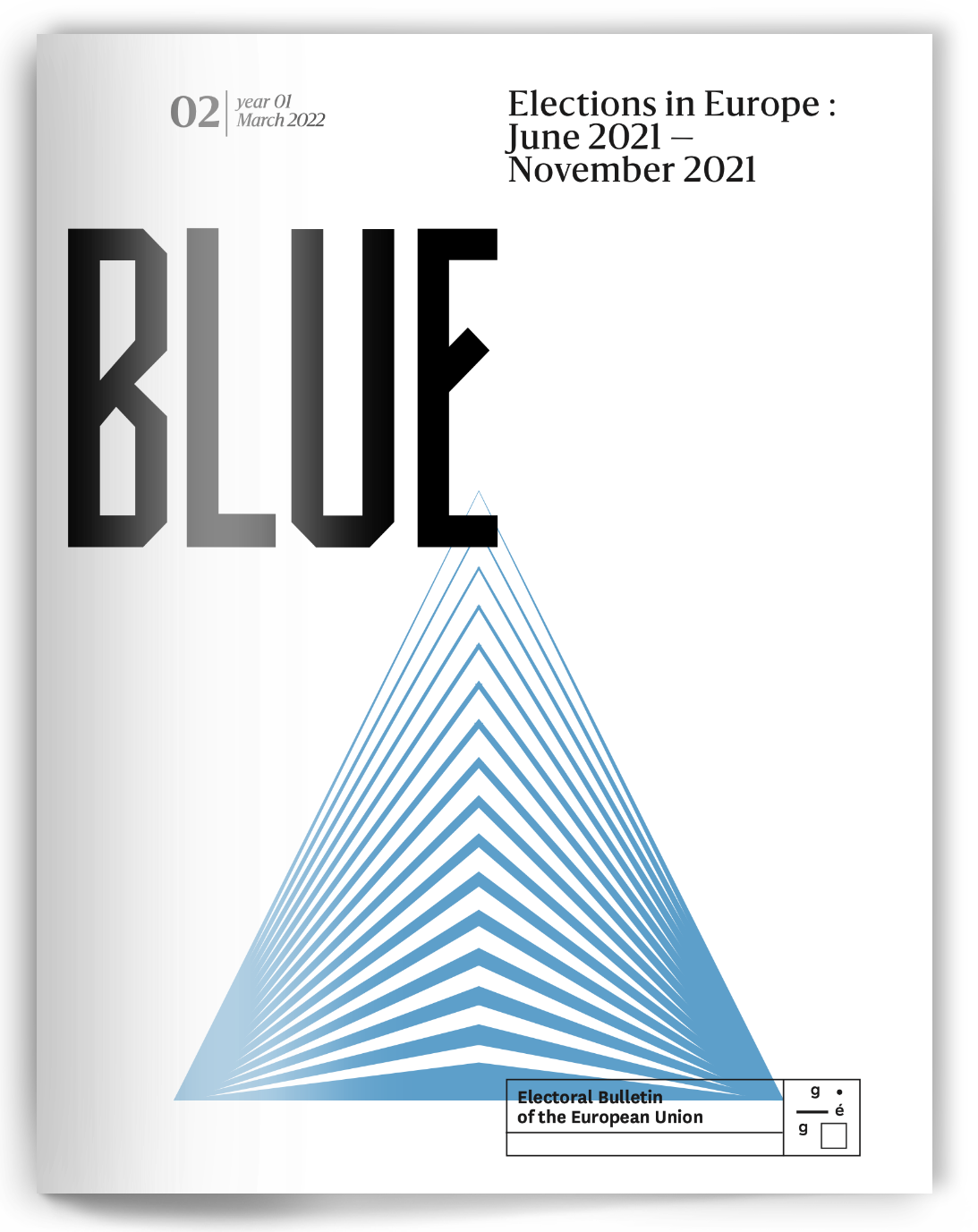
21x29,7cm - 167 pages Issue 2, March 2021 24,00€
Elections in Europe : June 2021 – November 2021
The 2016 election to the Berlin House of Representatives gave rise to new political equilibria in the German federal capital. The ruling ‘Große Koalition’ had experienced a period in office marked by crises: its management of the refugee crisis, corruption scandals and the delay in the opening of the BER airport had led to much criticism of the state government. At the ballot box, the coalition lost massively: together, the two ‘people’s parties’ got only 39.2% of the vote; the CDU (EPP) reached an all-time low nationwide, while the SPD (S&D) got the narrowest government mandate of the post-war period with 21.6% of the second votes. For its part, the fledgling AfD (ID) entered the House of Representatives for the first time (Niedermayer 2017). A red-red-green government coalition emerged — the second of its kind at state level, and the first under SPD leadership. In December 2016, Michael Müller (SPD) was re-elected as Governing Mayor of Berlin (Niedermayer 2017); he had taken over the office from party colleague Klaus Wowereit in 2014. Thus, despite considerable losses, the Berlin SPD continued to lead the state government. It has been part of the government without interruption since 1989.
Political context, election campaign and the vote
Berliners were critical of the work of the Red-Red-Green Senate, as the Berlin government is known, throughout the 2016-2021 legislative period. In the year of his re-election, Müller’s satisfaction ratings dropped from over 50% to just under 30% (Fahrun 2021). Afterwards, the survey values recovered slightly, but Müller was permanently among the most unpopular minister presidents in Germany (WDR 2019). Satisfaction with the Senate’s coronavirus crisis management was particularly low: in 2020, Berlin ranked third-last among German states in surveys (Kühne et al. 2020 : 7); in spring 2021, the state government’s satisfaction ratings deteriorated even further (Fahrun 2021).
At the beginning of 2020, Müller announced that he would use the next Berlin election as an opportunity to switch from state to federal politics (Schütze 2020). In his place, the then Federal Minister for Family Affairs, Senior Citizens, Women and Youth and former District Mayor of Neukölln Franziska Giffey and Member of the House of Representatives Raed Saleh were elected as co-chairs of the SPD state association of Berlin (Kiesel 2020). Finally, in April 2021, Giffey was named the SPD’s top candidate for the upcoming elections to the House of Representatives (FAZ 2011).
The fact that Giffey was at the centre of accusations of plagiarism caused widespread criticism. When it became apparent in mid-May 2021 that an investigation initiated at the end of 2020 would result in the revocation of her doctorate (FU Berlin 2021), Giffey resigned her ministerial post (Spiegel 2021). Supported by her party, she nevertheless decided to enter the Berlin election campaign.
Giffey’s popularity was rated significantly lower than that of her predecessor in the run-up to the election. Only 36% of respondents supported her in a (virtual) direct election for mayor, against 53% in 2016 for Müller. However, her main opponents Kai Wegner (CDU) and Bettina Jarasch (Greens) were still significantly less popular than her, with 17% and 12% respectively (Infratest dimap 2021b).
Parallel to the elections to the House of Representatives, the elections to the German Bundestag, elections to Berlin’s district councils and the (non-binding) petition for a referendum “Expropriate Deutsche Wohnen & Co.” took place on 26 September 2021. The initiative calls for the expropriation of large housing companies and the socialisation of their flats in order to counteract the rise in rents. However, there are doubts about the constitutionality of the plan; the “rent cap” passed by the Senate in 2020 already failed in 2021 due to a ruling by the Federal Constitutional Court (BVerfG 2021). The Left, (GUE/NGL), the Greens (Greens/EFA) and Young Socialists supported the proposal; the SPD, CDU and FDP rejected it. The issue of housing shortage, which has long been the focus of Berlin state politics anyway, thus came even more to the fore.
However, housing was not the only issue of the election campaign. In election day polls, the issues of environment and climate (20%), social security (17%) and economy and labour (16%) were even mentioned more often than housing (15%) as the most important issue of the election (Infratest dimap 2021b).
With regards to climate policy, the SPD advertised a “social-green deal” and aimed for complete climate neutrality by 2050. The Left Party and the CDU named 2040, the Greens 2035 as the time horizon. The Greens were the only party to propose making the inner city a zero-emissions zone by 2030. The centre-right parties and the AfD, for their part, mainly favoured more green spaces and better renovated buildings.
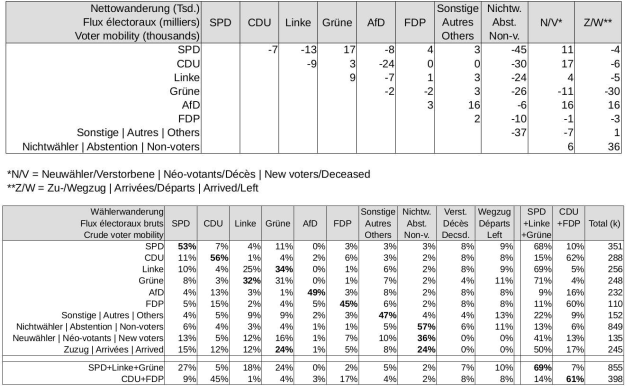
In the areas of economy and social affairs, the SPD demanded an increase of the state minimum wage to 13€, the CDU a reduction of the trade tax, and the FDP bureaucracy reduction as well as easing the legal burden for business founders. The Left Party, on the other hand, proposed the establishment of a public industrial holding company. The SPD sought a further development of the pilot project “Solidarity Basic Income” for the long-term unemployed, the Greens a new pilot project for an unconditional basic income. The AfD campaigned for a “welfare state brake,” bureaucracy reduction and more public investment.
1
As of 2018, the Greens in particular were dominant in the polls. Only with the beginning of the Coronavirus pandemic did the CDU experience a surge in popularity, which, however, subsided again in 2021. The Greens became the strongest force again until the SPD overtook them mid-2021. This dynamic coincided with a similar development at the federal level, which was favoured in particular by the high popularity of the SPD’s federal top candidate, Olaf Scholz (Schmitt-Beck 2021).
An unusually high number of irregularities were reported on election day. The state election director reported “delays in sending absentee ballots”, “wrong or missing ballots”, “interruption of the voting process”, long waiting times and late closures affecting 9% of Berlin polling stations (RND 2021). The state election administration, the federal election administrator as well as about 30 private persons filed objections (Merkur 2021). At the beginning of February, the Berlin Constitutional Court sent out the relevant letters of objection to 740 parties involved. They have until the end of March 2022 to submit their comments (Berlin 2022).
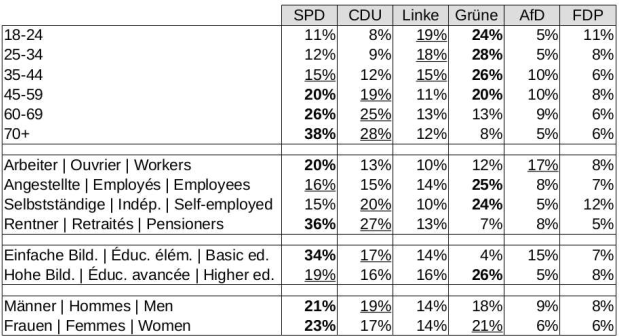
Analysis of the results
On 26 September 2021, the incumbent red-red-green coalition was confirmed in office. Its overall vote share increased slightly compared to 2016, from 52% to 53% of the second votes; the SPD remained the strongest force in the House of Representatives. Unlike at the federal level, however, there can hardly be any talk of a social democratic election victory. Within the centre-left camp, there was a clear shift in favour of the Greens. While the Greens achieved their best result ever (18.9%, +3.7 percentage points [pp]), the SPD suffered a slight (21.4%, -0.2 pp) and the Left Party a moderate (14.0%, -1.6 pp) decline in its share of the vote. The Greens celebrated a symbolic victory in addition to the arithmetic one, overtaking both the CDU and the Left Party to become Berlin’s second strongest force. With 21.4%, the SPD recorded the worst result for a state election winner in the history of the Federal Republic.
The centre-right camp had been at a historically low level in 2016 (CDU: 17.6%, FDP: 6.7%). In 2021 it made only modest gains: the CDU won 18.1% of the vote (+0.5 pp), the FDP 7.2% (+0.5 pp).
The AfD was the only major party to lose massively, losing almost 40% of its electorate and coming in at just 8.0% (-6.2 pp) — a development common to all state elections of the year, but most pronounced in Berlin. None of the other parties that stood in the election were able to clear the five-percent hurdle. More than one percent of the second votes went to the Tierschutzpartei (2.2%, +0.3 pp), the PARTEI (1.8%, -0.1 pp), the “Querdenker” party dieBasis (1.3%, new), the Euro-federalist Volt (Greens/EFA, 1.1%, new), and Team Todenhöfer (1.0%, new). The effective number of parties (Laakso & Taagepera 1979), which quantifies the fragmentation of the party system, was 6.81 (2016: 6.63); this only moderate increase is mainly due to the low electoral shares of new parties.
At 75.7% (+8.8 pp), voter turnout reached its highest level since 1995. The fact that the Berlin election was held at the same time as the Bundestag election for the first time since 1990 probably contributed significantly to this unusually high turnout. This effect was also clearly evident in Mecklenburg-Western Pomerania, where elections were held on the same day.
Finally, the referendum “Expropriate Deutsche Wohnen and Co.” was passed with 59.1% of the vote (turnout: 73.5%). According to polls, however, only a minority of Berliners (35%) demand that expropriation be implemented as called for by the initiative committee, while a larger group (48%) would like to see other measures. It seems likely that many voters supported the initiative primarily because of its signal effect (Infratest Dimap 2021b).
Voter mobility
The analysis of voter mobility
2
allows deeper insights into Berlin’s electoral dynamics. We will explain four major trends, namely a) the high volatility within the centre-left electorate, b) the particular success of the Greens among first-time voters and those who moved to Berlin, c) the major influence of the voting behaviour of former non-voters on the final result, and d) the migration of many AfD voters to the centre-right camp, but also to new protest parties.
a) Berlin’s centre-left voters who neither died nor moved away since 2016 remained 83% loyal to the coalition. Their binding rate is thus clearly higher than that of the centre-right parties (73%) and the AfD (58%). However, this stability vis-à-vis non-coalition parties was accompanied by strong instability within the coalition. Only 64% of former SPD voters supported the same party in 2021, against 37% and 30% of Greens and Left voters, respectively. A remarkable “voter exchange” took place between the Left and the Greens: more Left (42%) and Green (38%) voters switched to the other party than there were voters who re-elected “their” party. The Greens were the main beneficiaries of this internal realignment, while the Left Party lost most of its votes to its coalition partners.
b) The reason for the Greens’ success can also be found outside the coalition. Of all the parties, they had the most success among first-time voters and newcomers to Berlin. Among new voters they got 25% of the votes (SPD: 20%, Left: 18%), among newcomers even 31% (SPD: 19%, CDU: 16%). Since the latter group is three times as large as the former, its net contribution is significantly higher: the Greens gained 30,000 voters through internal migration, but only about 11,000 through generational change (deaths and first time voters). This corresponds to about 1.6% and 0.6% of the votes cast, respectively.
c) The sudden increase in voter turnout mainly benefited the SPD and CDU. Of the 700,000 former non-voters who cast their ballots, 26% voted for the SPD, 16% for the CDU, 14% for the Greens and 13% for the Left. A high proportion (20%, about 43,000 people) supported other parties. The offer of the unconventional party dieBasis and the Freie Wähler, which is particularly aimed at “people who are disillusioned with politics” (Politikverdrossene, see Arzheimer 2013) and critics of the Coronavirus measures, could explain part of this tendency.
d) Over 50% of the voters who voted for the AfD in 2016 voted differently or not at all in 2021. About 8% of them have died, another 8% have moved away. About one in five AfD voters still living in Berlin switched to the centre-right camp, one in ten to the other parties; only 2% did not vote. The AfD’s decline is thus not a sign of demobilisation of the AfD electorate in the sense of an increased tendency to abstain; rather, it results from the combined effect of demographic change (-32000 net votes), voter migration to the centre-right parties (-27000) and the success of other (protest) parties (-16000).
Socio-demographic analysis
As in all other German elections in 2021, there was a clear correlation between the voting ratio and generational affiliation. With the over-sixties the SPD and CDU dominated, while younger generations voted above average for the Green Party. A specific feature of Berlin is the popularity of the Left Party among younger voters. In 2021, the Left Party was even able to improve its results in younger age groups.
Generational patterns provide a partial explanation for the “voter exchange” between the Left Party and the Greens described above, which should, however, be confirmed by further data. The migration from Green to Red could be mainly due to younger voters who were looking for a left-wing alternative to the Greens in this election, while at the same time many older Left voters switched to the Greens.
Clear patterns also emerge with regard to occupational groups and education levels. For example, the AfD is the second strongest force among workers with 17% (self-employed: 5%). The Green electorate consists almost exclusively of people with higher education (proportion with “basic education”: 4%), while people with “basic education” vote disproportionately for the SPD (34%) and AfD (15%).
The relationship between gender and party choice is much more balanced. Only for the AfD (men: 9%, women: 6%) and the FDP (men: 8%, women: 6%) does the difference between the parties’ percentage vote shares among female and male voters exceed 25% of their total vote share. While women were still significantly overrepresented among the Green electorate in 2016 (difference: 4 pp, i.e. 25% of a total of 15.2%), in 2021 the difference has almost halved (difference: 3 pp, i.e. 16% of a total of 18.9%).
Geographical analysis
Of the 78 direct mandates in Berlin, the SPD won 26, the Greens 23, the CDU 21, the Left Party 6 and the AfD 2. Clear geographical patterns can be discerned: the Greens won most of their direct mandates in Berlin’s inner city, the Left Party east of the inner city, and the AfD in eastern Marzahn-Hellersdorf. The CDU’s strongholds are on the western, northern and north-eastern periphery, while the SPD dominates in a ring between the centre and periphery and in the south-east. In 2016, the majority ratios were still different: The Greens won significantly fewer constituencies, while most constituencies in the eastern part of the city were dominated by the Left Party or the AfD.
A principal component analysis of the results reveals two different trends. On the one hand, there is disproportionate green and left-wing voting in the inner city. This is mainly at the expense of the CDU, but also the SPD, the AfD and the FDP. On the other hand, there is still a East-West division, which in many places still corresponds to the former course of the Wall: in the East, the Left and AfD are represented above average; in the West, it is the Greens, CDU and FDP. The exception in this respect are four centrally located constituencies (in Mitte, Friedrichshain and Prenzlauer Berg), which despite their “eastern” location show a clearly “western” voting behaviour.
A cluster analysis confirms the three-way division of political Berlin into a western, an eastern and a central part. In the western cluster, the CDU dominates with 28%, followed by the SPD with 25%. In the eastern cluster, the SPD is in the lead with 21%, second is the Left Party with 18%. In the central cluster, consisting of most constituencies in the inner city and some neighbouring areas, the Greens dominate with 28%, followed by the Left with 20% and the SPD with 18%. The Berlin government has an absolute majority mainly in the inner city and in parts of Treptow-Köpenick. Thus it can be said without exaggeration that in Berlin the centre rules over the periphery.
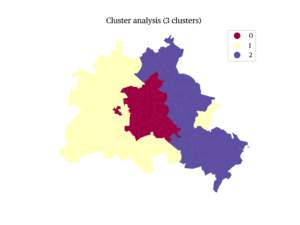
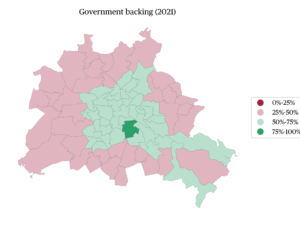
Aftermath
After about ten days of exploratory talks, Giffey declared on 14 October her wish to continue the previous red-red-green coalition (Spiegel 2021b). The coalition agreement was presented on 29 November 2021 (Coalition Agreement 2021), adopted by all three parties in December, and on 21 December Giffey was elected and sworn in as Governing Mayor of Berlin in the plenum (Zeit 2021). In addition to Giffey, the new senate includes 4 SPD, three Green and three Left senators, including mayors Bettina Jarasch (Bündnis 90/Die Grünen) and Klaus Lederer (Die Linke). The balance between the parties thus remains unchanged compared to the outgoing Müller II senate.
Behind this supposed stability lies a profound structural change in Berlin politics. The strong momentum of the Greens, who have been able to further expand their electoral share and benefit greatly from demographic change, is evident. This is typical of large Western European cities, as shown, for example, by the French municipal elections in 2020. The FDP and especially the Left Party also do particularly well among younger voters. The former dominance of the SPD, on the other hand, is visibly eroding: in 2021, the SPD was able to save its first place mainly thanks to the votes of older generations, higher voter turnout and other positive contamination effects from the federal level.
In view of the weakness of the centre-right camp and its concentration in peripheral districts, only left-of-centre coalitions (possibly including the FDP) remain conceivable in Berlin. In a highly fragmented party landscape, where party affiliation follows clear geographic and socio-demographic patterns, this development brings new democratic challenges.
On 26 September, the attention of the German and European public was primarily focused on the Bundestag elections. Standing in its shadow, the House of Representatives election had little impact on the political mood beyond Berlin. For the time being. As the decision of the Berlin Constitutional Court in the ongoing election review proceedings is still pending.
Literature
Arzheimer, K. (2013). Politikverdrossenheit: Bedeutung, Verwendung und empirische Relevanz eines politikwissenschaftlichen Begriffs. Springer-Verlag.
ARD (2021, 27 September). Wie die Wähler wanderten. ARD. Online.
Bömermann, H. (2017). Räumliche Struktur der Ergebnisse der Abgeordnetenhauswahl von Berlin am 18. September 2016-ein Werkstattbericht: Sind Choroplethenkarten alternativlos?. Zeitschrift für amtliche Statistik Berlin-Brandenburg, 1, pp. 58-67.
Berlin (2022, 3 February). Der Verfassungsgerichtshof beteiligt zahlreiche Personen und Institutionen in den Wahlprüfungsverfahren. Press release. Online.
BVerfG (2021). Gesetz zur Mietenbegrenzung im Wohnungswesen in Berlin („Berliner Mietendeckel“) nichtig. Press release, Bundesverfassungsgericht. Online.
Fahrun, J. (2021, 24 February). Berliner sind unzufrieden mit der Corona-Politik des Senats. Berliner Morgenpost. Online.
FAZ (2021, 24 April). Giffey ist SPD-Spitzenkandidatin für die Wahl in Berlin. Frankfurter Allgemeine Zeitung. On line.
FU Berlin (2019). Freie Universität Berlin beschließt, Dr. Franziska Giffey für ihre Dissertation eine Rüge zu erteilen – der Doktorgrad wird nicht entzogen. Press release. Online.
FU Berlin (2021). Freie Universität Berlin entzieht Franziska Giffey den Doktorgrad. Press release. Online.
Gschwend, T. (2008). Abgeordnetenhauswahlen sind keine Bundestagswahlen. Oder doch? Erfahrungsbericht aus Berlin. Nomos Verlagsgesellschaft mbH & Co. KG, pp. 93-121.
Infratest dimap (2021). BerlinTREND April 2021. Online.
Infratest dimap (2021b). Wahltagumfragen zum Abgeordnetenhaus von Berlin 2021. Online.
Kiesel, R. (2020, 28 November). Die Berliner SPD demonstriert Einigkeit – und setzt alles auf Franziska Giffey. Der Tagesspiegel. Online.
Kühne, S. et al. (2020). Gesellschaftlicher Zusammenhalt in Zeiten von Corona: Eine Chance in der Krise?, SOEPpapers on Multidisciplinary Panel Data Research, 1091, Deutsches Institut für Wirtschaftsforschung (DIW), Berlin.
Laakso, M., & Taagepera, R. (1979). “Effective” number of parties: a measure with application to West Europe. Comparative political studies, 12(1), pp. 3-27.
Merkur (2021, 21 December). Untersuchung zu Problemen bei Wahl in Berlin: Mehr als 30 Personen legen Einspruch ein. Merkur. Online.
Niedermayer, O. (2012). Die Berliner Abgeordnetenhauswahl vom 18. September 2011: Grün war nur die Hoffnung, die Realität ist rot-schwarz. Zeitschrift für Parlamentsfragen, pp. 18-35.
Niedermayer, O. (2017). Die Berliner Abgeordnetenhauswahl vom 18. September 2016: Zersplitterung des Parteiensystems und halber Machtwechsel. Zeitschrift für Parlamentsfragen, pp. 40-56.
RND (2021, 14 October). Endgültiges Ergebnis der Berlin-Wahl steht – aber Unregelmäßigkeiten in 207 Wahllokalen. Redaktionsnetzwerk Deutschland. Online.
RND (2021b, 20 November). Pannen in Berliner Wahllokalen: Verfassungsrechtler schließt Wahlwiederholungen nicht aus. Redaktionsnetzwerk Deutschland. Online.
Schmitt-Beck, R. (2021). Wahlpolitische Achterbahnfahrt. Wer wählte wen bei der Bundestagswahl 2021?. Aus Politik und Zeitgeschichte: APuZ, 71(47-49), pp. 10-16.
Schütze, E. (2020, 29 January). Michael Müllers doppelter Rücktritt. Berliner Zeitung. Online.
Spiegel (2021, 19 May). Familienministerin Giffey tritt zurück. Der Spiegel. Online.
Spiegel (2021b, 29 September). Berliner Landeswahlleiterin tritt zurück. Der Spiegel. Online.
Spiegel (2021c, 14 Octobre). SPD-Chefin Giffey strebt Regierung mit Grünen und Linken an. Der Spiegel. Online.
WDR (2019, 24 February). WDR Westpol-Umfrage: Jeder Zweite in NRW hält Kohleausstieg 2038 für zu spät. WDR. Online.
Zeit (2021, 21 December). Giffey neue Regierende Bürgermeisterin von Berlin. Zeit. Online.
Programmes électoraux et contrat de coalition
SPD (2021). Ganz sicher Berlin. SPD Landesverband Berlin. Online.
Grüne (2021). Grünes Licht für Morgen. Bündnis 90/Die Grünen Berlin. Online.
CDU (2021). Unser Berlin. Mehr geht nur gemeinsam. CDU Berlin. Online.
Linke (2021). rot. radikal. realistisch. Die Linke Berlin. Online.
AfD (2021). Berlin. Aber normal. AfD Berlin. Online.
FDP (2021). Regierungsprogramm. Holen wir uns die Zukunft. FDP Berlin. Online.
Koalitionsvertrag (2021). Zukunftshauptstadt Berlin. Online.
Notes
citer l'article
François Hublet, Regional election in Berlin, 26 September 2021, Mar 2022, 117-123.
à lire dans cette issue
voir toute la revue







